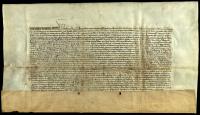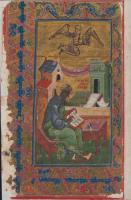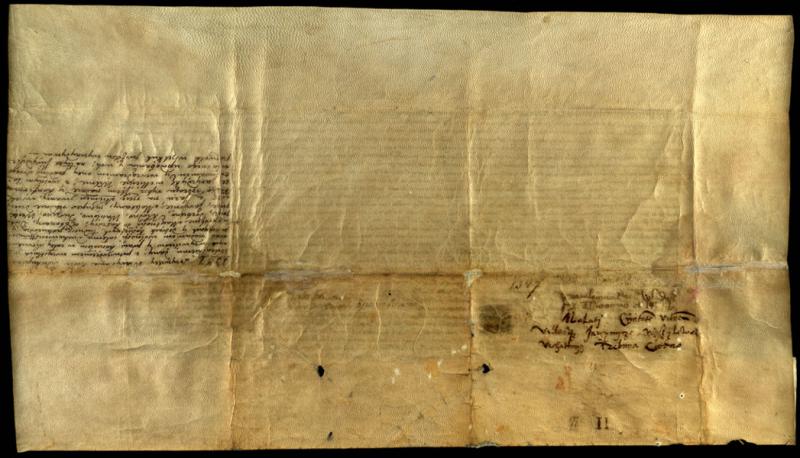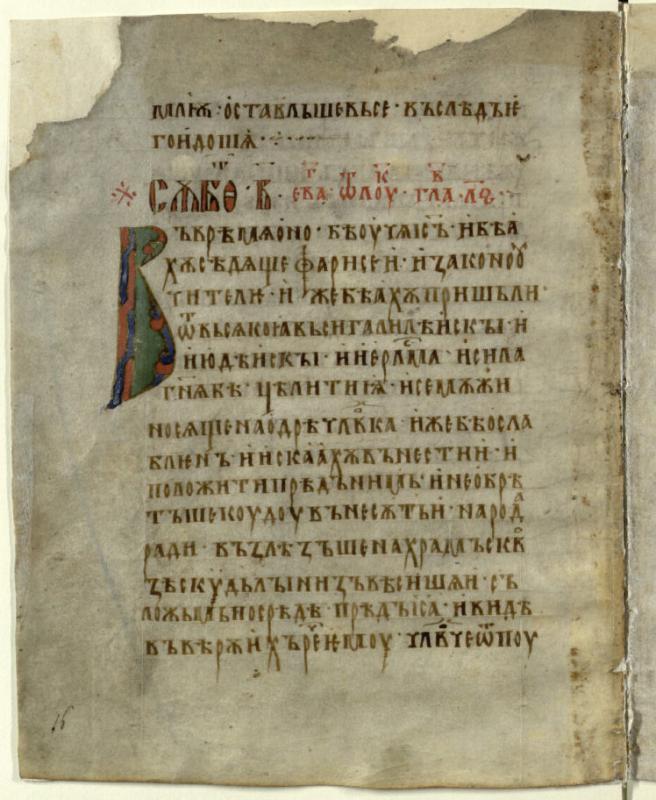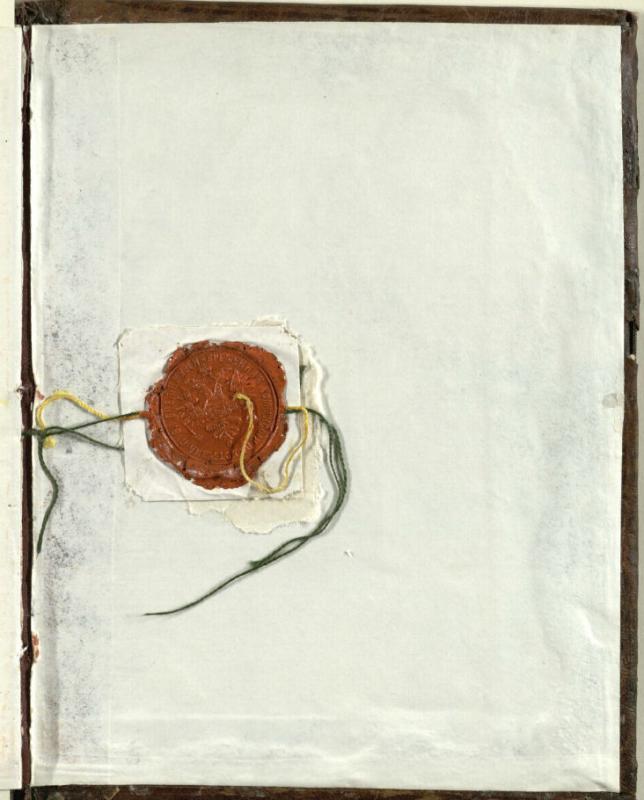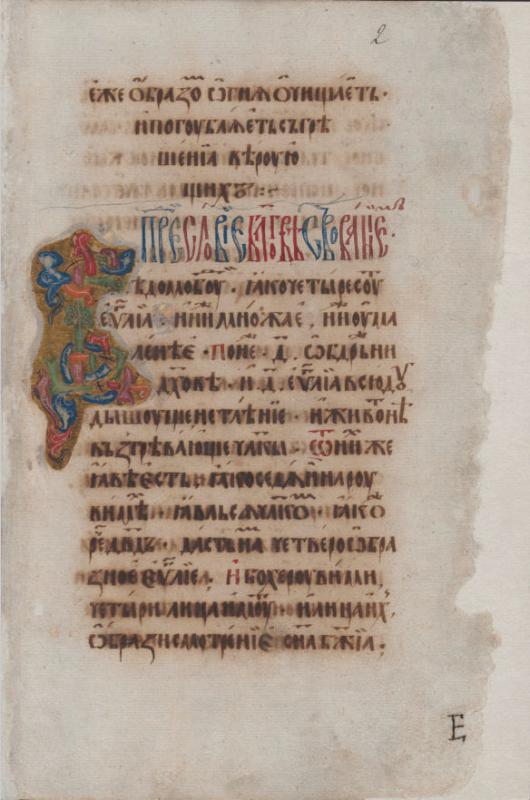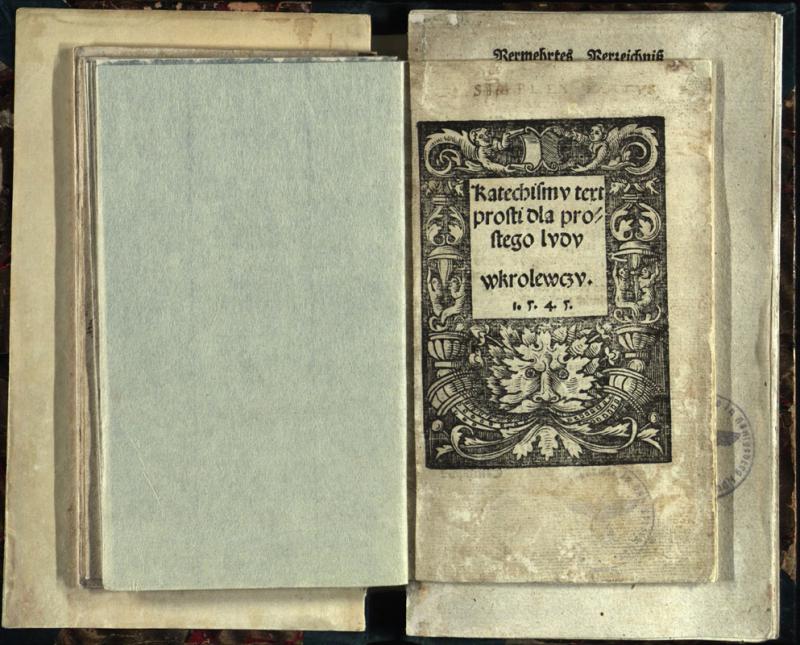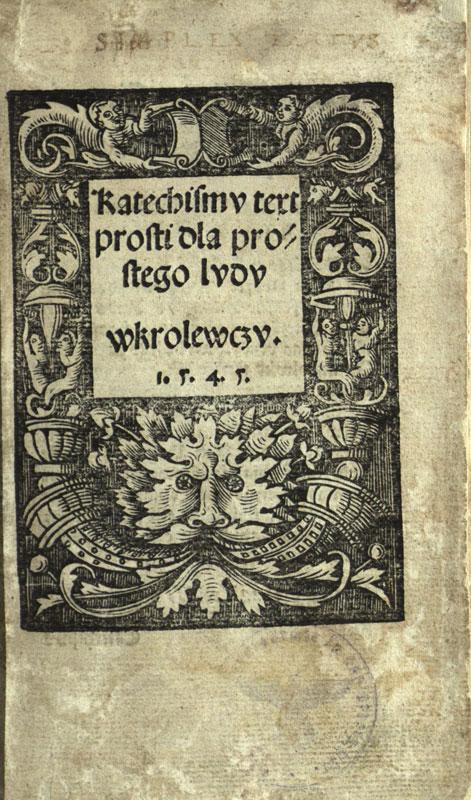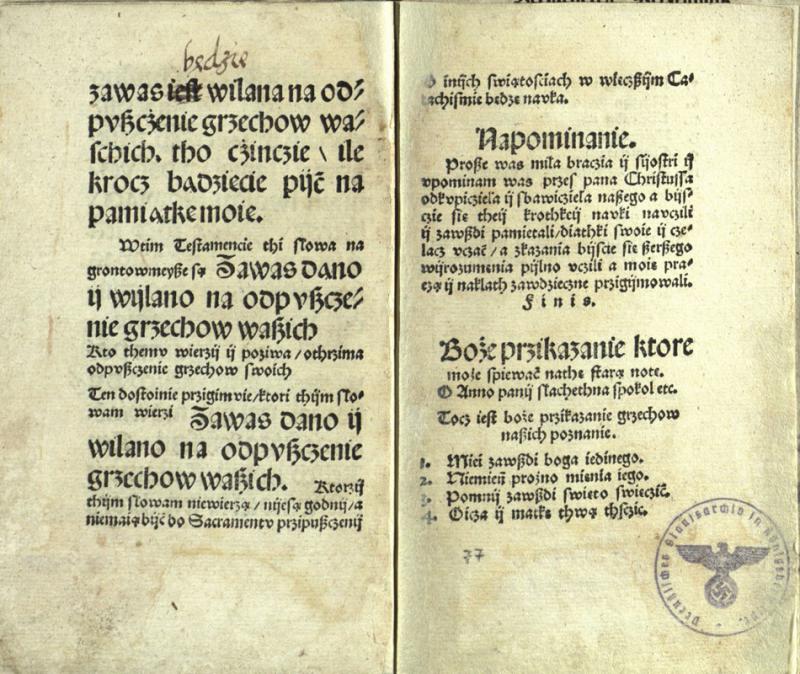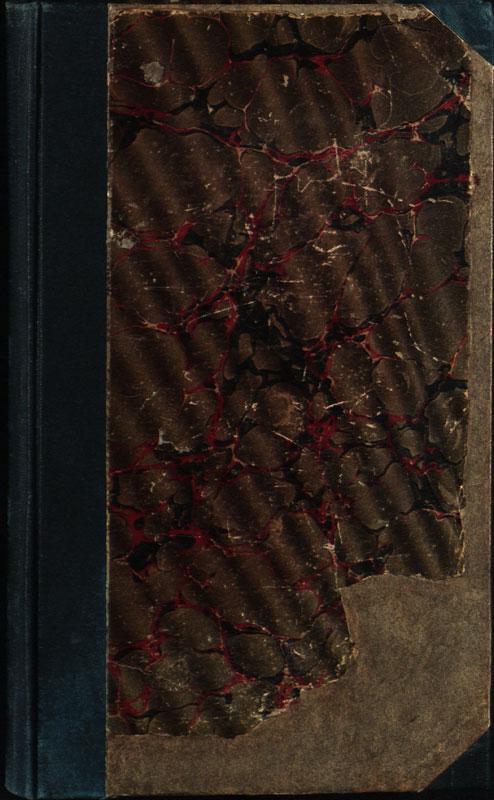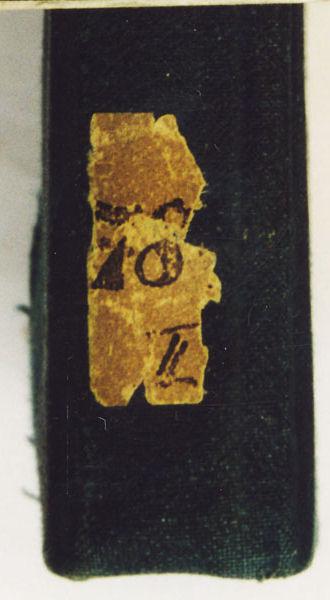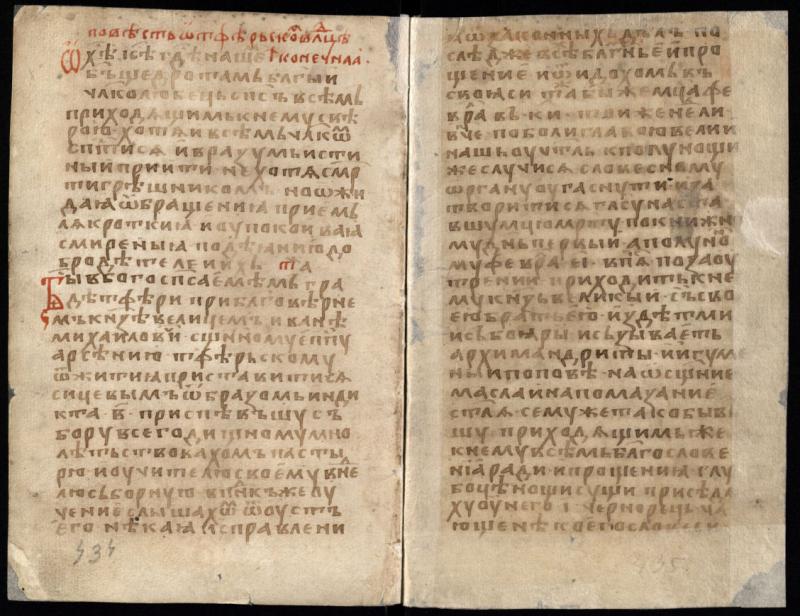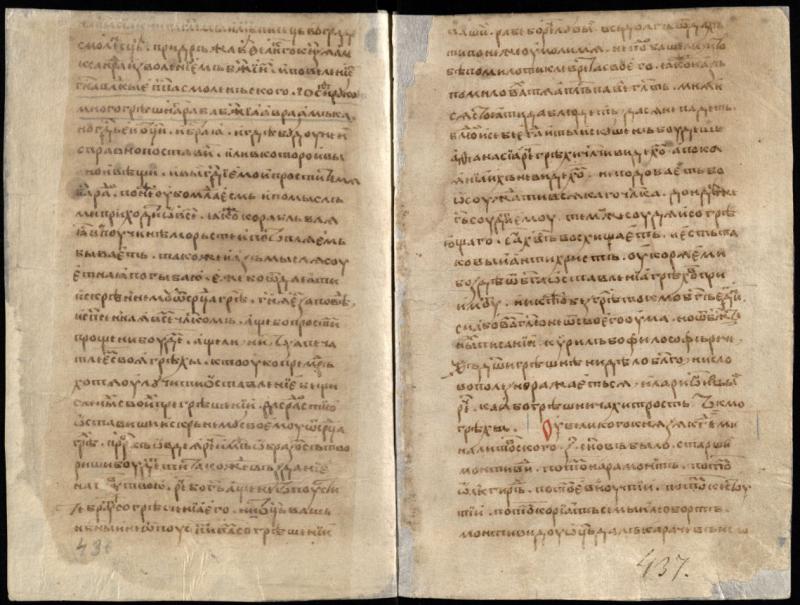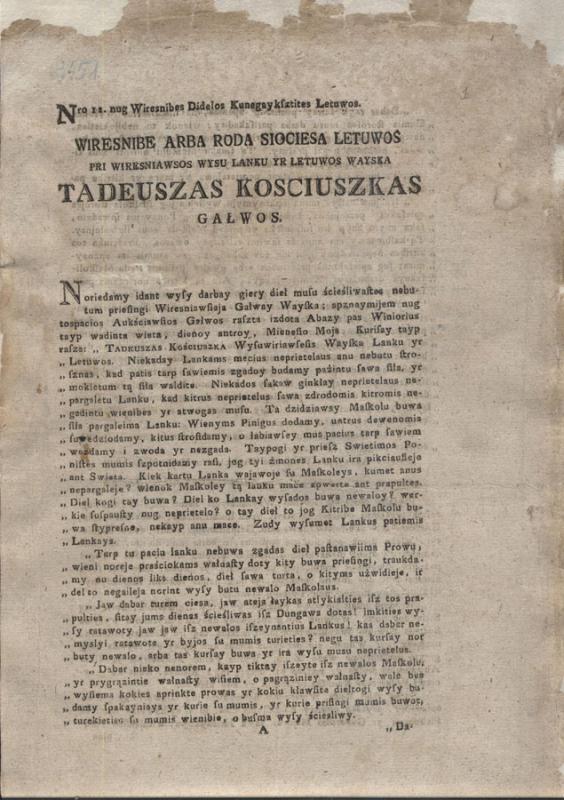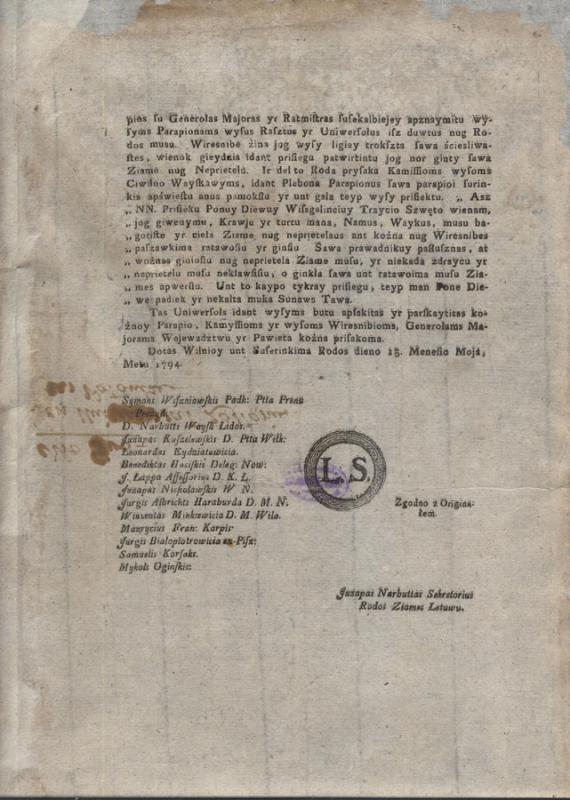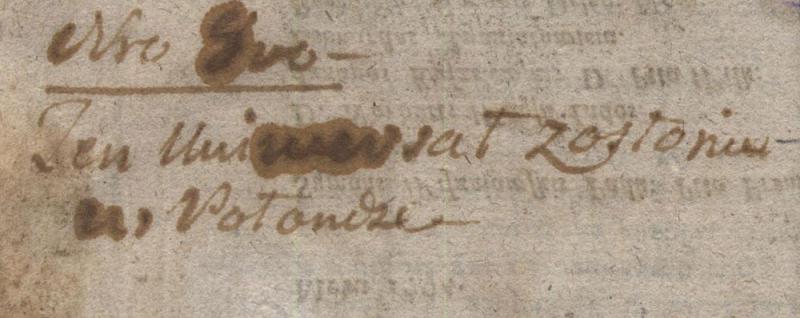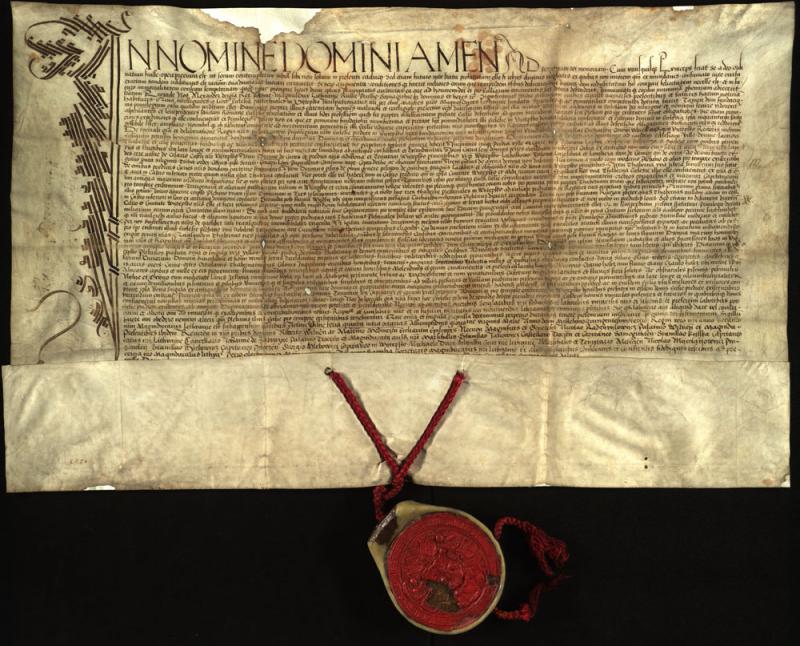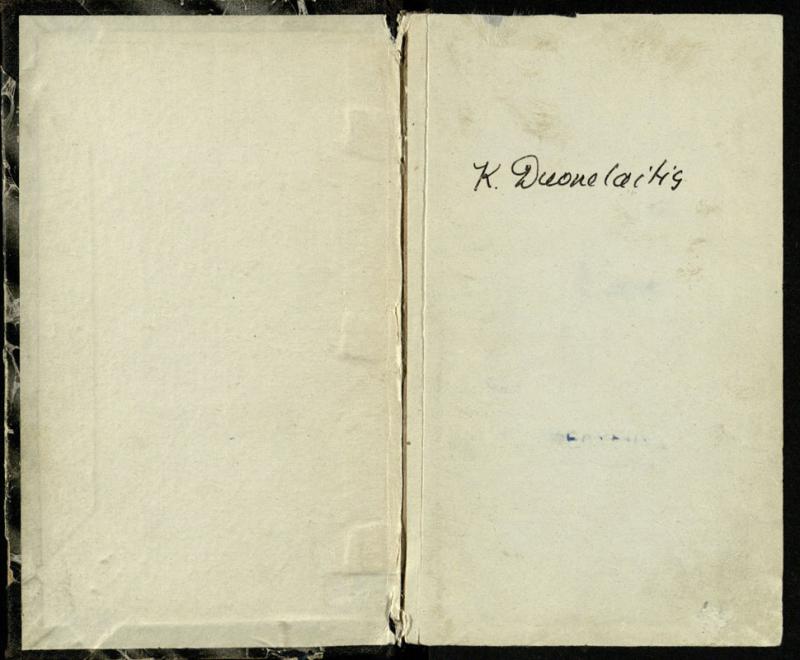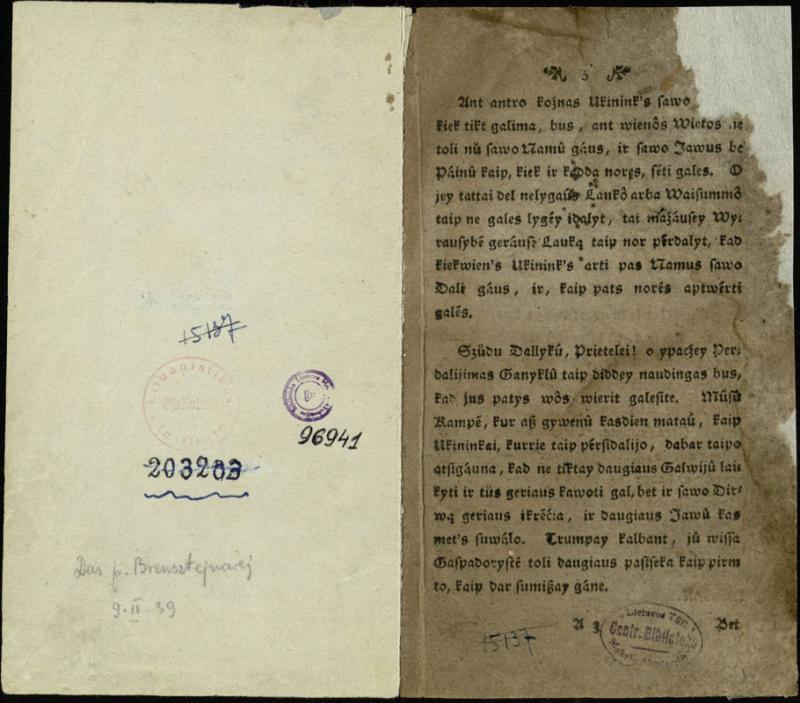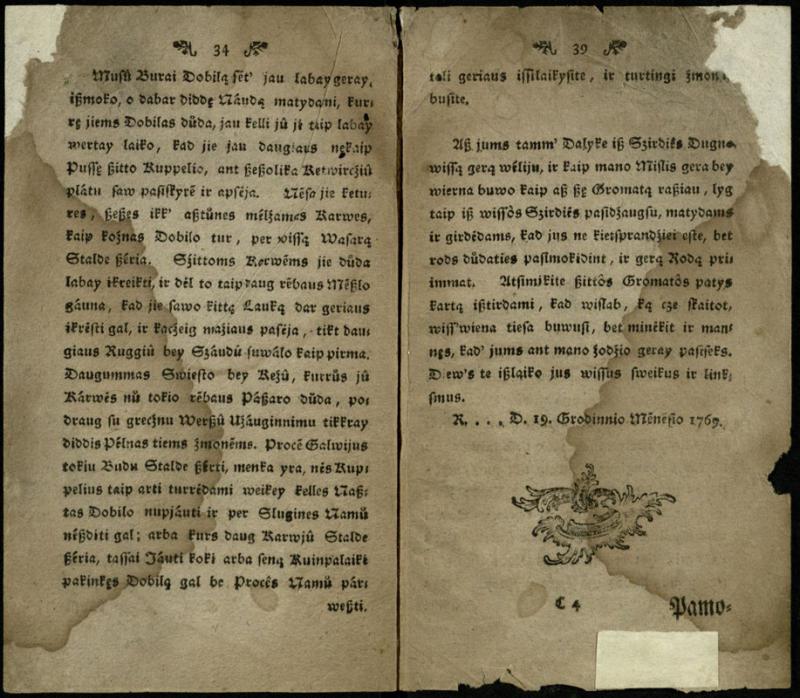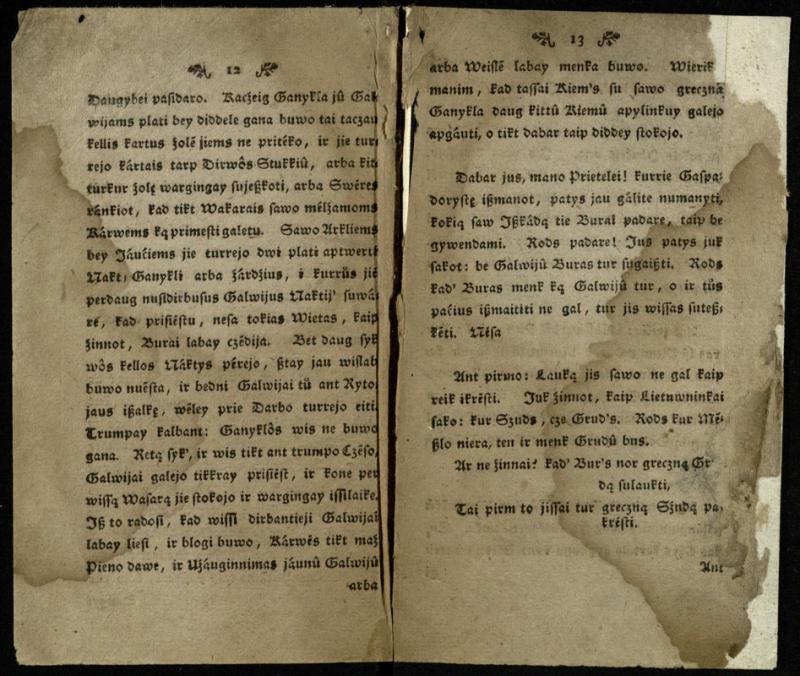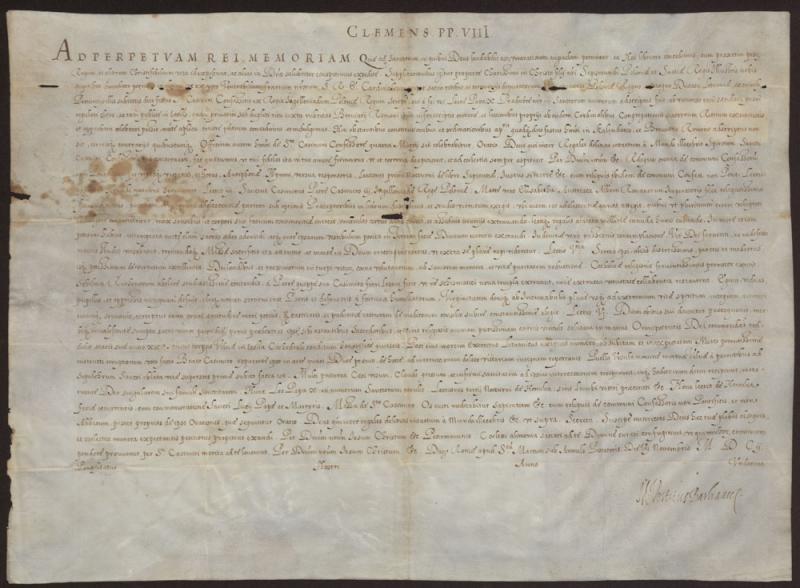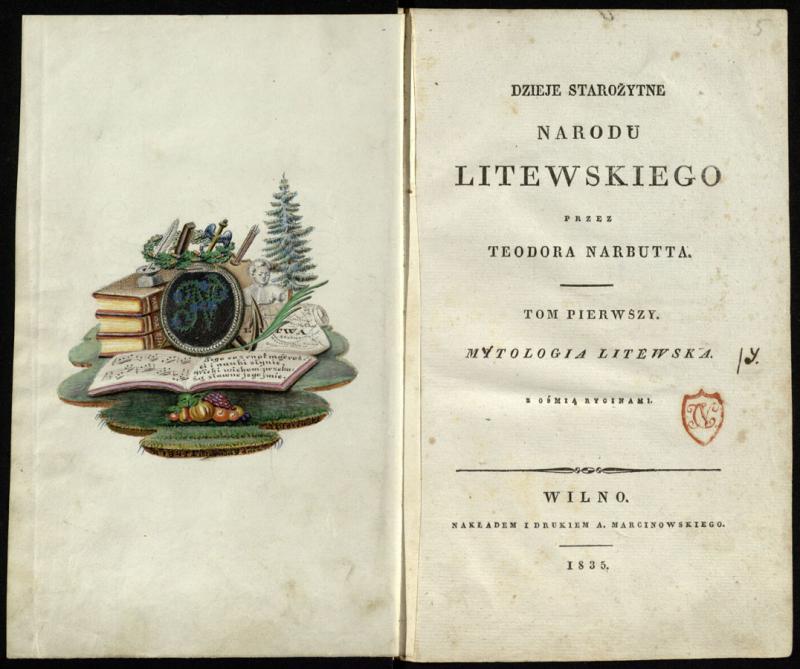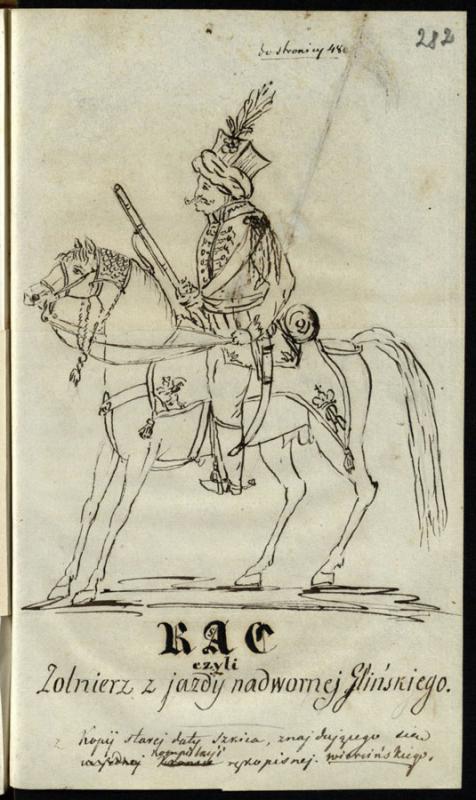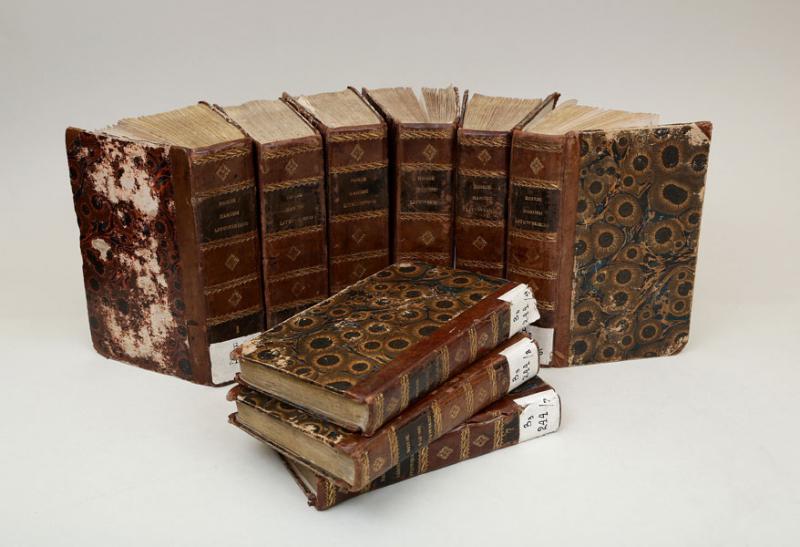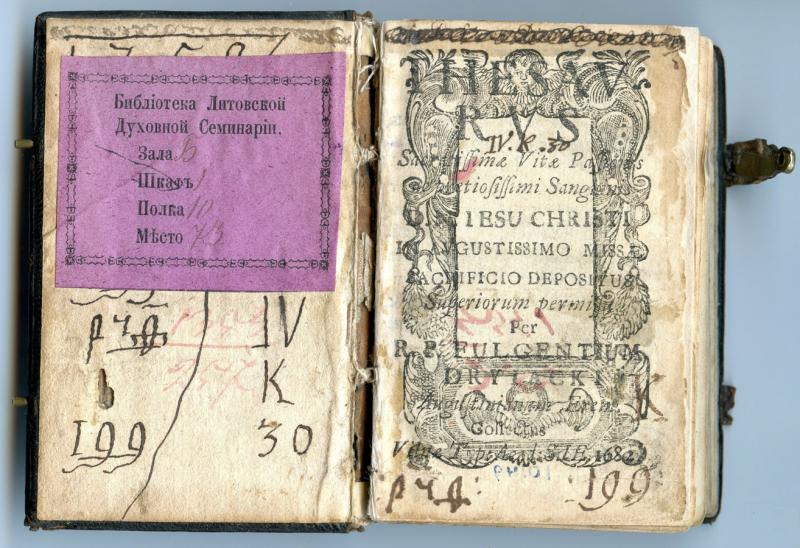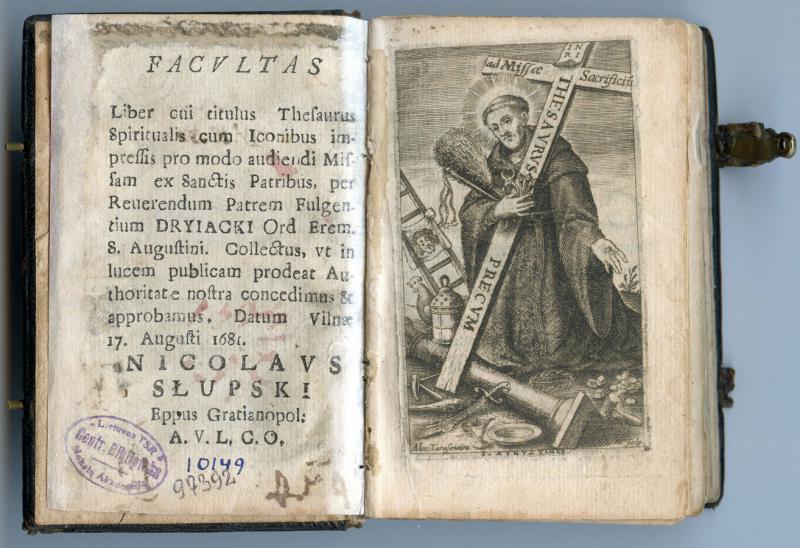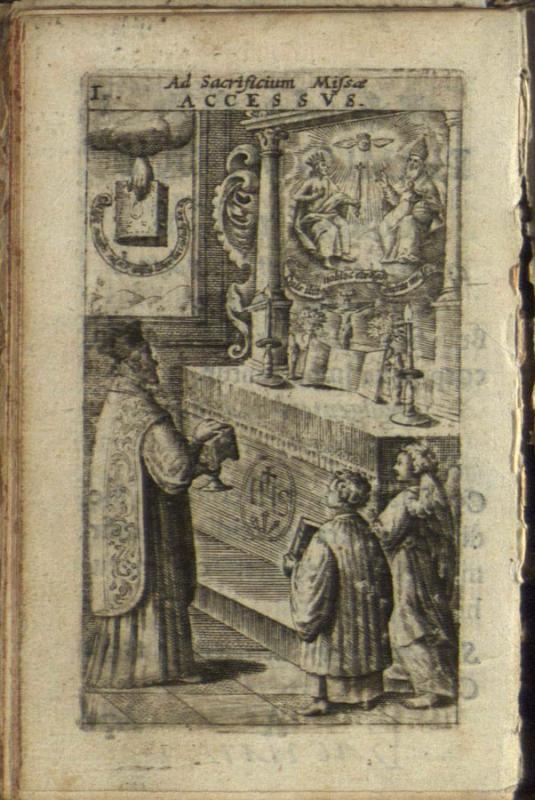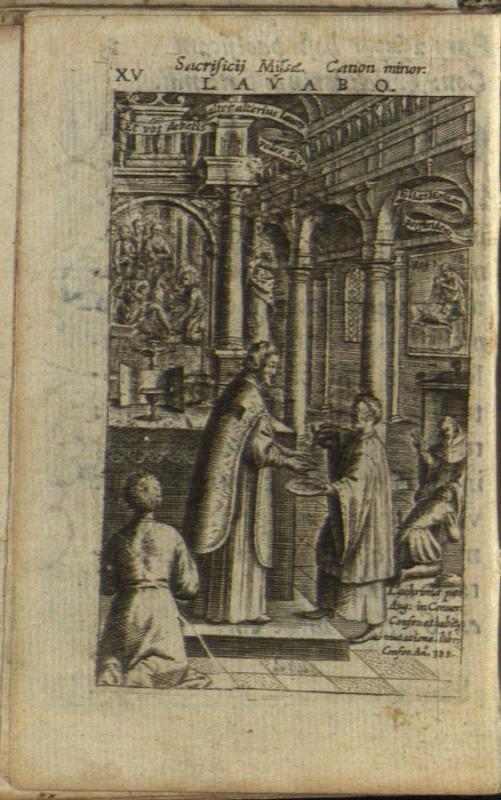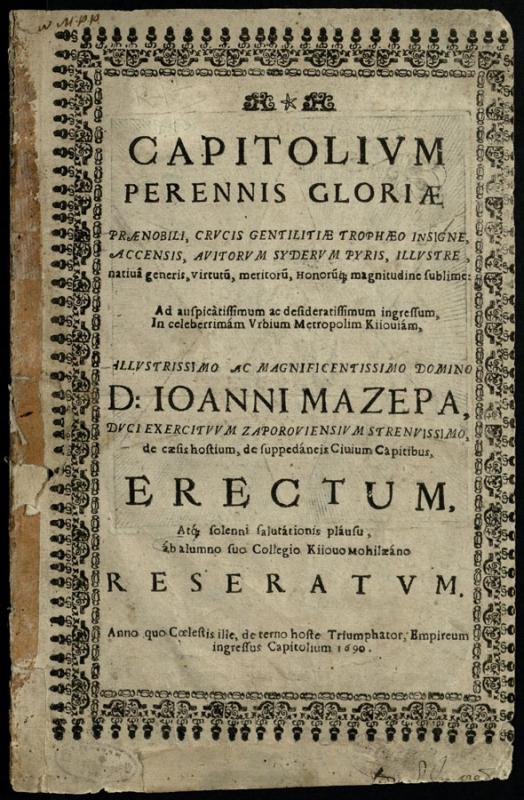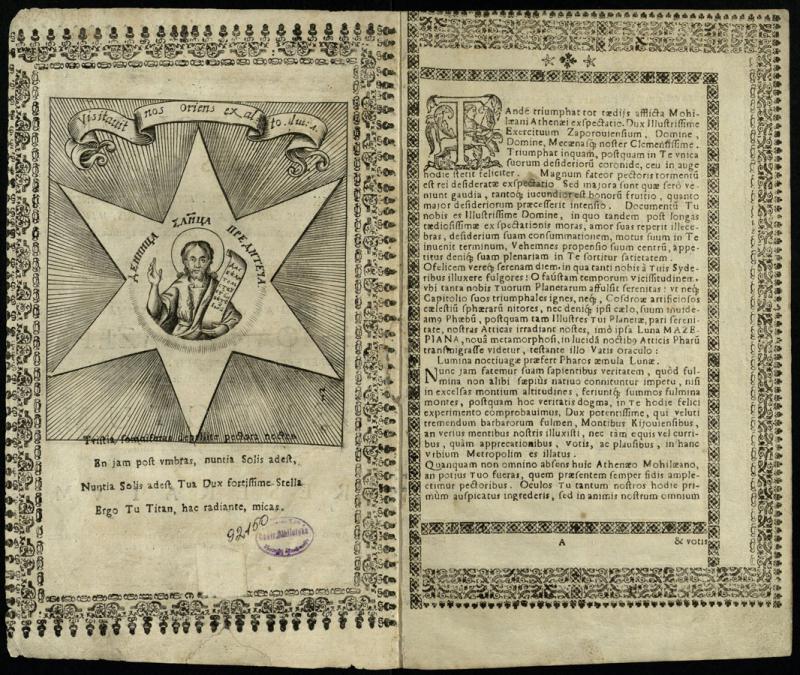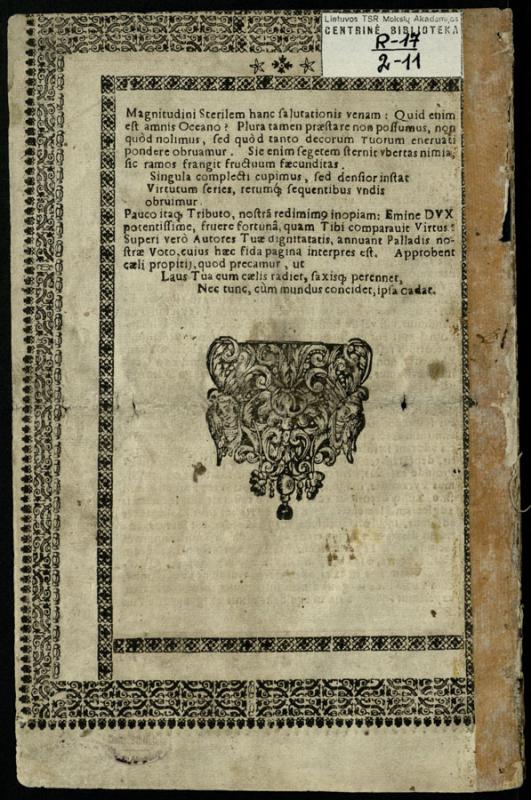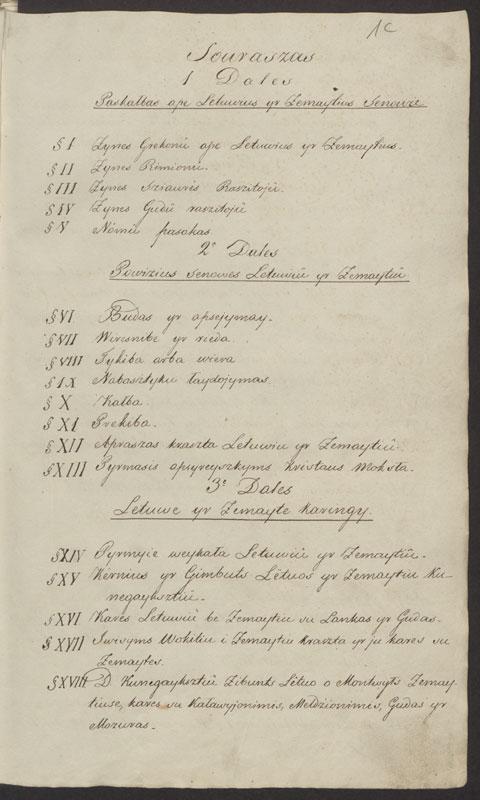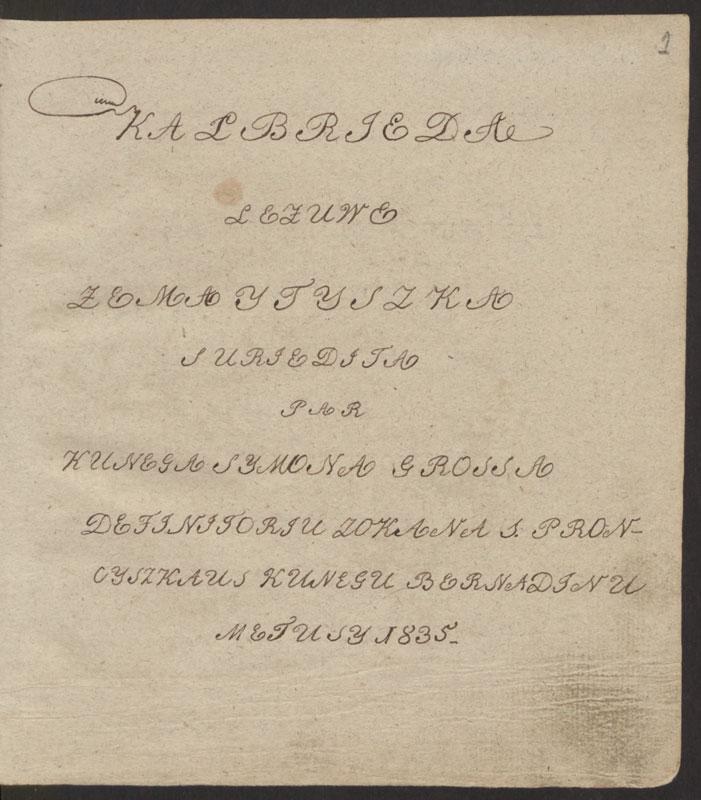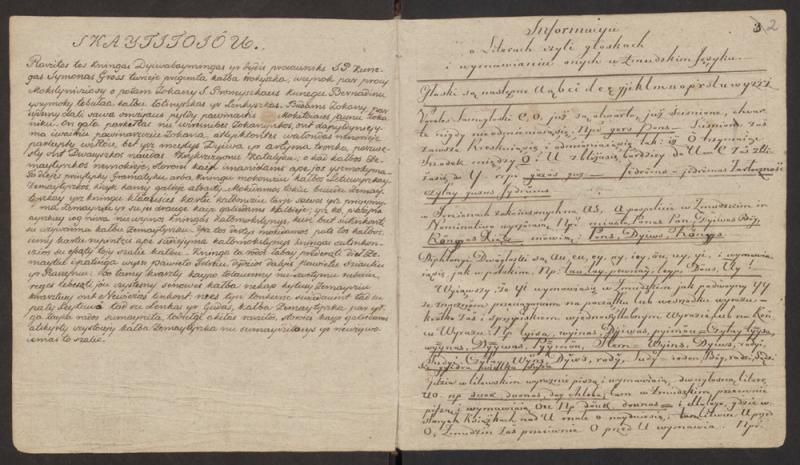Exhibition Objects
2006:
This is the oldest parchment document written, and now kept, in Lithuania. By this charter, the church of the Vilnius castle and the bishop were granted the possession of the castle of Tauragnai and its district, the villages of Labanoras and Molėtai, the districts of Dambrava, Verkiai and Bokštas, part of the city of Vilnius, several houses in Vilnius, etc. In other words, by this charter, Jogaila set up, and provided for, the Vilnius Diocese. The document indicates the coming of Christianity to Lithuania. The process of Christianization started by Jogaila had an enormous social, political and cultural significance for the development of the Lithuanian state.
The document was previously kept in the Chapter of the Vilnius Cathedral. It was handed over to the then Library of the Lithuanian Academy of Sciences from the State Restoration Workshop at the time of construction repairs on Vilnius Cathedral. The charter, along with some other parchments, was put in the collection “Parchments from the Archive of the Vilnius Chapter” (F6) created in the Manuscript Department.
2007:
Writing in maroon ink; 18 text lines on each page; script: ustav book hand; 11 initials (O, P, B) drawn in the Old Byzantine style in red, blue and green colors, outlined in black.
This is the oldest monument of written culture kept in the Republic of Lithuania, and one of the 14 extant 11th-century examples of writing in the Old Church Slavonic on the territory of the former Soviet Union. The Gospel attests to the origins of spiritual and material lifestyle and of the book culture of the Orthodox Church on the territory of the Grand Duchy of Lithuania, as well as reflects the religious, cultural, ethnic and civic context of the state.
The fragment of the concise selection from the Gospels for holidays known as the Turov Gospel, was found in 1865, by a teacher called Nikolay Sokolov, in the course of an archaeographic expedition: it was discovered in a coal box in Turov, near Minsk (the present-day Belarus). He brought the priceless manuscript to the Manuscript Department of the Vilnus Public Library (the inner side of the top cover has a label: Виленская Публичная Библiотека No. 1). In 1915, the Gospel was taken away to Russia along with other valuables kept in this library and put into the holdings of the Rumyantsev Library (in the Soviet time, it was called the Lenin State Library) in Moscow. After World War II (between 1946 and 1952), the Gospel was returned to Lithuania and placed into the Russian Manuscript Books Collection of the Manuscript Department of the Wroblewski Library of the Lithuanian Academy of Sciences.
The inscriptions made on May 2, 1508 (fol. 6v), and February 10, 1513 (fol. 2v) and concerning donation of land by the Grand Hetman of Lithuania Konstantinas Ostrogiškis (Konstanty Ostrogski), his wife Tatyana and son Ilya to the clergymen Mitrofan and Matvey suggest that the Turov Gospel might have belonged to the monastery of the Church of the Transfiguration of Jesus in Turov. In the 18th century, the above-mentioned donations of land were reconfirmed by new inscriptions.
2008:
The writing is in maroon ink, the initials and rubrics are in red and blue ink; the text on each page is arranged in one column that has 18 lines; script: ustav; the text has 10 decorated initials (И, Л, Г, B) and five tailpieces with plant motives painted in red, blue and green on a gilded background. The Gospel is decorated by 4 miniatures: a portrait of the St. Matthew the Evangelist on a gilded background in fol.10v; St. Mark the Evangelist in fol. 114v; St. Luke the Evangelist in fol. 185v; St. John the Evangelist in fol. 297v. The miniatures of this Gospel (color combinations) and text decorations display an influence of the Christian Western art. The garland motive is made up by stylized plant branches with sprouting acanthus leaves; ornamental compositions are Renaissance.
The Sapieha Gospel (also called the Zhyrovichy Gospel in Belarus) is one of the most lavishly decorated manuscript masterpieces kept in Lithuania. The gospel reflects the tradition of book culture, of the spiritual and material life of the Orthodox Church in the Grand Duchy. It is a brilliant example of the synthesis of the Slavic and Western European book art. On October 29, 1613 Jonas Meleška (Jan Mieleszko), the Castellan of Smolensk together with his wife Ona Fursaitė (Anna Fursówna) founded a Basilian (Uniate) monastery in Zhyrovichy. The first head of the monastery was Juozapatas Kuncevičius (Josaphat Kuntsevych), later the Archbishop of Polotsk. His steadfast faith and ardent sermons attracted to the monastery crowds of believers, including rich benefactors (this is suggested by a donation inscription found in the Gospel: Bogdana Jonaitė Meleškienė (Bogdana Joanowna Mieleszkowa Przeclawska) confirming the monasteryʼs ownership of a home farm donated by her ancestors (fol. 295v‒297r).
The Chancellor of the GDL Leonas Sapiega (Lew Sapieha) was peerless in his generosity towards the Basilians. In 1616, he gifted them with lands, buildings, and several villages, equipped the church with luxurious liturgical items, and donated a great bell. He must also have gifted them the Gospel. The book bears an inscription to that effect (fol. 376r–377r), and is called the Sapiehaʼs Gospel for this very reason.
In the 17th–18th century, Zhyrovichy was a religious center of the Uniates. In 1763, the Sapieha Gospel must still have remained in Zhyrovichy, as suggested by an inscription in the folia 53r–64r. After the liquidation of the Church Union in 1839, the administration of the Lithuanian Orthodox Archdiocese moved to Zhyrovichy, where the main church became a cathedral (sobor), and the former Uniate seminary became Orthodox. Later, the Sapieha Gospel together with other books was transferred to the library of the Orthodox Seminary of Lithuania, and from there, to the Vilnius Public Library (the inner part of the upper cover has a label: Рукописное отдъленiэ Виленской Публичной Библiотеки No. 150). In 1915, together with other valuables from this library, the Gospel was taken away to Russia and put into the holdings of the Rumyantsev Library (in the Soviet time, it was called the Lenin State Library) in Moscow. After World War II (between 1946 and 1952), the Gospel was returned to Lithuania and placed into the Russian Manuscript Books Collection of the Manuscript Department of the Wroblewski Library of the Lithuanian Academy of Sciences.
This is a short Evangelical catechism in Polish compiled by a prominent publisher of Protestant literature, Jan Seklucjan, and printed in Königsberg in the printing house of Hans Weinreich. This copy of the publication is unique, the only one known so far. It is bound within a composite volume of six books published in Eastern Prussia in the 18th–early 19th century. This important example of Polish printed heritage at the same time throws light onto the cultural history of Lithuania because of its connections to the origins of Lithuanian-language printing. It is supposed to be one of the main sources used by Martynas Mažvydas (circa 1510–1563) in writing his Chatechismusa prasty szadei, makslas skaitima raschta yr giesmes, the first Lithuanian-language print book, published by the same printers as Seklucjanʼs catechism. According to Polish and German culture historians, the composite volume containing the unique copy of Seklucjanʼs publication before the World War II used to be kept in the Prussian State Archives in Königsberg. This copy carries handwritten corrections by another acclaimed Polish publisher of Protestant literature, Jan Malecki (circa 1490–1567), a fierce critic of the language and style of Seklucijan’s catechism. It is of interest that Mažvydas, writing his catechism, also used a Polish 1546 catechism compiled by the same Malecki whose marginalia are left in the extant copy of Seklucjan’s catechism.
Seklucjan was born in Bydgoszcz, studied in Leipzig University in 1536–1538, then read sermons in Poznań. In 1543 he came to Königsberg and actively engaged in Polish-language publishing under the patronage of the Duke of Prussia, Albert of Brandenburg. He edited and published the first Protestant Polish works: a hymnal (1547), the New Testament (1551–1553), and a postilla (1556). In Königsberg, he became acquainted with Lithuanian literary men: Abraomas Kulvietis, Stanislovas Rapolionis. The latter was especially supportive of Seklucjan’s creative work.
The binding of this volume is from a later period (the first half of the 20th century). This is clear because of the simple binding technique and marbled paper cover. The spine of the composite volume carries remains of a label with numerals 78, and below them, numerals II. The stamps visible in the book testify to the place of keeping suggested by all the researchers: Preussisches Statsarchiv in Königsberg.
After World War II, Seklucjan’s catechism was thought to have been lost: no sources could give an indication about its fate. The Wroblewski Library received the volume owing to efforts of the expeditions sent to the Königsberg region in the wake of the war. It was put away for half a century in the Reserve Holdings to be identified in 1997, incidentally the 450th anniversary of the first print book in the Lithuanian language.
2011:
Stiff yellowish paper with watermarks. Script: semi-ustav with elements of chancery script (fol. 1‒435) and small semi-ustav (fol. 436‒450), light brown ink, large initials in cinnabar. Chapter titles are in a decorative vyaz script (вязь).
Lithuanian chronicles are important documents of our cultural history. These historiographical texts from the 14th–16th century give account of the political history of the Grand Duchy of Lithuania. Chronicles provide us with much information on the life in the Grand Duchy and thus are a valuable narrative source for the history of the Lithuanian state. The emergence of the first chronicle texts is connected to Grand Duke Vytautas. The authors of the first texts are unknown, their protographs are lost or remain undiscovered, and the circumstances of their appearance are known only roughly. The texts were written in the Ruthenian chancery language used in the Grand Duchy and disseminated in handwritten transcripts. About 30 transcripts of Lithuanian Chronicles of various length and nature (created before and in the 18th century) are known today. The Lithuanian Chronicles were grouped into three compendiums: The First (Short) Redaction, the Second Redaction and the Extensive Redaction (or the Bykhowiets Chronicle). The First Redaction, compiled in the mid-15th century and containing early Lithuanian chronicles from the late 14th–early 15th century, is the one most valuable as a historical source.
The First Redaction is defined as the oldest monument of the Duchy’s historiography, the first link in the chain made up by the Lithuanian Chronicles, the Chronicle by Motiejus Strijkovskis (Maciej Stryjkowski, 1582), and the History of Lithuania by Albertas Kojalavičius-Vijūkas (Albertus Wiiuk Kojalowicz, 1650, 1669). The First Redaction is not only a historical source, but also a fine example of medieval written culture, a text whose literary elements (legends with folklore origins, setting descriptions, dialogues, psychologically-motivated action) influenced the development of Lithuanian fictional literature. Six primary versions of the transcripts of the First Redaction or its fragments are known today. They are dated to the 15th–16th century. The oldest of them is thought to be the Vilnius transcript, also called “Avraamka’s Chronicle”. It was copied in 1495 (7003 by the Byzantine calendar), presumably by the monk Avraamka, on the orders of the then Bishop of Smolensk, Iosif Bulgarinovich. This redaction recounts the events from 854 to 1446, and arguably, the summary of the compendium of the Moscow Chronicles.
The codex was found by A. V. Rachinski in Polotsk in 1864, who eventually handed it over to the Vilnius Public Library, founded in 1895. In 1915, together with other valuables from this library, Avraamka’s Chronicle was taken away to Russia and put into the holdings of the Rumyantsev Library (in the Soviet time, it was called the Lenin State Library) in Moscow. After World War II (between 1946 and 1952), Avraamka’s Chronicle was returned to Lithuania and placed into the Russian Manuscript Books Collection of the Manuscript Department of the Wroblewski Library of the Lithuanian Academy of Sciences.
This document of the uprising of Tadeusz Kosciuszko (Tadas Kosciuška) names civil liberties granted to the families of the serfs participating in the uprising and recounts the oath given by the participants. The circular was signed by 14 members of the Supreme National Council of Lithuania, including such distinguished men as the poet and political writer Mauricijus Pranciškus Karpis (Maurycy Franciszek Karp); the composer, diplomat, and Treasurer of the Grand Duchy Mykolas Kleopas Oginskis (Michał Kleofas Ogiński); the Secretary of the Council Juozapas Narbutas (Józef Narbutt). This Lithuanian-language document is a rare and important example of Lithuanian political press: the prevailing majority of such publications were lost in the wake of the repressions by the Tzarist authorities. The present copy is unique, the only one in the repositories of Lithuanian institutions. Its value is even more increased by its provenance: the Wroblewski Library received the document from Vaclovas Strimaitis, the Bagotoji parish priest, who, in his turn, obtained it from the priest Bronius Vaišnora. The latter had discovered the proclamation in Baisogala about 1955‒1960. According to historiographic sources, a Vilnius resident, the priest Juozapas Stankevičius had owned a copy of this circular before 1939. The copy kept in the Wroblewski library contains an inscription made in brown ink: Nr. [...] // Ten Uniwersał zostanie // w Połondze (I am leaving this proclamation in Palanga). This inscription most probably dates to the 19th century and indicates that one of 600 printed copies (the print run of this publication) had traveled as far as Palanga.
Writing: invocation in capitals, the decorated initial is as tall as the entire text; writing in brown ink, in Bastarda script. Seal: a medallion 95 mm in diameter. It features Vytis (Armed Horseman), the coat of arms of the Grand Duchy of Lithuania, topped by the Eagle (the arms of Alexander’s father, the King of Poland Casimir Jagiellon) and the Fess (the arms of the house of his Habsburg mother). On the sides of the Vytis are Archangel Michael (the coat of arms of the Kiev land) and the Cross (the coat of arms of the Volhynia land). The Bear (the emblem of the Smolensk land) is at the bottom of the seal. The seal is made of red wax, encased in a wax shell and attached to the document by a cherry-colored thread plait. The seal has a leather protection bag.
The election of Alexander as the Grand Duke of Lithuania (1492) meant the discontinuation of personal union between the Grand Duchy of Lithuania and the Kingdom of Poland. Lithuania again had a ruler who was not at the same time the king of Poland. This was of great importance for the development of the self-awareness of the Lithuanian political nation and the traditions in the statehood of Lithuania. On August 6, 1492, Alexander, by his charter to the nobility of Lithuania, declared the sovereignty of the state of Lithuania and the integrity of its territory. In the face of danger from the Duchy of Moscow, Alexander aimed to unite the people of Lithuania, in particular solving confessional problems arising between the Catholic and the Orthodox Christians. An idea to achieve a church union in Lithuania resurfaced in the environment of his court. Grand Duke Alexander supported cities, promoted crafts and trade, built churches and monasteries, and made them generous gifts.
He also reorganized the work of the state chancery, so that consistent work started on developing the state archive, the Lithuanian Metrica. Seeking to represent the state both domestically and abroad, Alexander introduced a set of three types of Lithuanian seals into use in the Chancery of Lithuania. In addition to the previously used Small Seal, he brought in the Great State Seal and the private signet of the Grand Duke, a considerable innovation in state sphragistics. The Great Seal had an especially high ideological and representational significance.
By means of heraldry, it not only showed the ancestry of the Grand Duke and his relations with the prominent European dynasties, but also the state under his rule, specially emphasizing the outlying lands which became an ongoing point of contention with the neighboring states. The concept of the Great Seal created in the late 15th century remained relatively unchanged for almost a century. Some of its elements, in the early 16th century, were transferred by Sigismund the Old even into the Great Seal of the Kingdom of Poland. The Great Seal was important for developing a more modern concept of state sovereignty, whereby state matters were separated from the private matters of the ruler.
Four seals from the time of Grand Duke Alexander, related to his Lithuanian activities, are known today: the signet seal of Prince Alexander (1492), the Small Seal of Lithuania (1505), the signet seal of Grand Duke Alexander (1500) and the Grand Seal of Lithuania (1503), the latter kept in the Manuscript Department of the Wroblewski Library, or more precisely, in the collection of parchments from the Vilnius Chapter. The Great Seal of the Grand Duchy of Lithuania seals the charter (Vilnius, 1503-08-17) signed by Alexander, the Grand Duke of Lithuania and granted for the foundation of a church in Vitebsk. The corroboration of the charter contains a statement that the ruler ordered to affix the sigillum nostrum Magni Ducatus Lithvanie to the charter. This seal is the only extant sphragistic artifact of its kind from the time of Grand Duke Alexander.
2013:
This significant example of 18th-century written culture presents a translation by Kristijonas Donelaitis, a famous Lithuanian classic author (1714–1780) whose poem “The Seasons” was written in the late 18th century and published in 1818. This translation of a decree of the King of Prussia concerning the usefulness of pasture separation contains a fragment from the “Summer Works” part of “The Seasons”, two lines only, printed here in Lithuanian for the first time. The title for this unique document (the only known copy in the world) was formulated by Vaclovas Biržiška (1884–1956) in 1939. At the end of the “Letter”, there is a date: D. 19. Grodinnio (t. y. November) 1769. Therefore, it may be supposed that the book was printed after November 19, 1769.
This little book with missing pages was given to the then State Wroblewski Library by a Mrs. Brenstein on February 9, 1939 (which is attested to by a pencil inscription in the front endleaf: Dar p. Brensztejnowej // 9. II. 39.). When the library was reassigned to the Institute of Lithuanian Studies, the book became the property of this institute (a round stamp: Lituanistikos instituto Biblioteka (The Library of the Institute of Lithuanian Studies) to be passed on, with the rest of the collections, to the Wroblewski Library of the Lithuanian Academy of Sciences. In the 1977 edition of Donelaitis’ works, this document is named as “A booklet on the usefulness of separation”. However, the Lithuanian national bibliography holds to the well-argued version of the title suggested by Biržiška. The text was published in the literary almanac “Varpai” (“Bells”), (Šiauliai, 1944, vol. 2), and in a collection of documents compiled by Povilas Pakarklis (1902–1955), Prūsijos valdžios gromatos, pagraudenimai ir apsakymai lietuviams valstiečiams (Letters, complaints and memoranda of the Prussian authorities to Lithuanian peasants, 1960).
The significance of this document lies in the then political and cultural context in Lithuania Minor: a need for an official translation from German into Lithuanian to communicate with the Lithuanian-speaking part of the population. The textual analysis of the document reveals its relations both to Lithuanian fictional and official, utilitarian,
publications. This document throws light not only on the development of the Lithuanian language and on the everyday life of the people of Lithuania Minor, but also on the manifold activities of such a classic of Lithuanian literature as Kristijonas Donelaitis.
2015:
A brief issued by Pope Clement VIII on November 7, 1602 completed the process of the canonization of Prince Casimir Jagiellon (1458–1484). In May 1603, the brief was brought to Vilnius from Roma by a Vilnius canon, Grigalius Svencickis (Gregorius Swiecicki). This document officially authorized the worship of Casimir as a Saint (already practiced in the Kingdom of Poland and the Grand Duchy of Lithuania) and set forth liturgical celebrations for the day of St. Casimir. The brief is equivalent to a decree of canonization – it is the first official document issued by the Holy See that refers to Casimir as a Saint. From this point onwards, the cult of St. Casimir spread not only within the Grand Duchy of Lithuania, but also in the entire of Europe.
St. Casimir was held to be a patron Saint of the city of Naples and of the Maltese Knights who fought Muslim Turks in the Mediterranean. The cult of St. Casimir spread worldwide through written accounts of his life and by the efforts of monks: in Venezuela, there is a city, a church and a parish bearing his name (San Casimiro); the Lithuanian and Polish Americans have over 50 St. Casimirʼs churches. There are 15 churches named for him in Lithuania, some more in Poland. The canonization of St. Casimir led to the proliferation of liturgical and literary texts, music and artworks dedicated to him. The cult of St. Casimir spread over the country through baptismal names, it permeated folk and fine art. Sculptures and pictures of St. Casimir may be found in churches, chapels, cities’ coats of arms. His cult is important for understanding Lithuanian spirituality. Miracles attributed to St. Casimir reveal the worries and troubles of the Grand Duchy’s people. After the third partition of the Polish-Lithuanian Commonwealth in 1795, Lithuania became part of the Russian Empire. In an effort to force the Orthodox faith onto the Lithuanians, the Russian government tried to interfere with the devotion of St. Casimir as the patron Saint of the country, turning his Vilnius church into an Orthodox church, and prohibiting the feast dedicated to him. While the Tsarist authorities persecuted the Catholics, the devotion of St. Casimir became a symbol of the fight for independence and the freedom of faith. The Society of St. Casimir, which was established in 1889 as a clandestine clergymen’s circle, printed and disseminated Lithuanian books. Its activities inspired resistance against the Russian occupation and Russianization; later, against Polonization in the Vilnius region at the time of the Polish occupation; and more recently, the “silent resistance” of the Soviet time. The worship of St. Casimir advanced the development of Lithuanian national self-awareness.
The document was previously kept in the Chapter of the Vilnius Cathedral, to be handed over to the Library of the Lithuanian Academy of Sciences from the State Restoration Workshop at the time of construction repairs on Vilnius Cathedral. The brief, along with other parchments from the archive of the Chapter, was put in the collection “Parchments from the Archive of the Vilnius Chapter” (F6) created in the Manuscript Department.
2017:
This is a multi-volume print book with handwritten notes, corrections, drawings, diagrams and other additions to the printed text in the hand of its author, Teodor Narbutt. He had been writing revisions of his historical treatise in the author’s copy for over three decades with a view to publishing a second edition. All revisions were made in the Šiauriai estate (the Vilnius Governorate, Lyda Region; the present-day Belarus, Grodno Region, Voranava District). Narbutt started writing revisions in his copy in 1835, immediately after the book had been published in the Antoni Marcinkowski’s printing house in Vilnius. Forced to leave the Šiauriai estate for Vilnius, he discontinued the work in 1863.
Teodor Mateusz Ostyk-Narbutt (1784–1864) was an acclaimed historian and civic figure in 19th-century Lithuania. His most notable work, The history of the Lithuanian nation, not only played a momentous role in Lithuanian historiography, but also awakened Lithuanian historical and national self-awareness. This is a unique testimony to the intellectual history of Lithuania in the 19th century, and to Lithuanian culture in general. The inscribed revisions, in a sense, expand the existence of the printed book, not only attesting to perpetual motions of the author’s mind, and not only reflecting reactions of the contemporaries to his work, but also indicating new sources (in his handwritten notes) for research in the history of Lithuania.
After the Šiauriai estate was seized by the Russian authorities to punish the Narbutt family for their participation in the 1863–1864 uprising, this nine-volume work, along with the entire library and archive kept in the estate, was transferred to the Vilnius Museum of Antiquities. Moved again in 1867, this time to the Vilnius Public Library, it was placed into the manuscript collection “B3” (room B, bookcase 3). In 1915, along with other valuables from this library it was taken to the Imperial Moscow and Rumyantsev Museum. This memory institution had a copious library with extensive collections of rare books and manuscripts, which became a foundation for the V. I. Ulyanov (Lenin) Russian Public Library (from 1925 on, the V. I. Lenin State Library of the USSR). The author’s copy of Narbutt’s multi-volume historical treatise was kept there until the fifth decade of the 20th century. After World War II (somewhere between 1946 and 1952), this copy along with other valuable items was returned to Lithuania to be placed into the Manuscript Department of the Wroblewski Library of the Lithuanian Academy of Sciences. Fortunately, the entire nine-volume set of this unique source has survived to this day. In Lithuanian memory institutions, there is no other such source that would testify to a historian’s everyday life and constant intellectual work.
This is the only known extant copy of a Catholic book of rituals compiled in Latin by the Augustine monk Fulgentas Dryjackis (Fulgenty Dryjacki), entitled “The Thesaurus of the Most Sacred Life, Torment and Precious Blood of Our Lord Jesus Christ” and decorated with engravings by Aleksandras Tarasevičius (Aleksander Tarasewicz). This unique publication is at once a testimony to the development of the liturgy of the Lithuanian Catholic Church, a significant example of Lithuanian religious literature, and a masterpiece of 17th-century Vilnius printing. The small-format book, commissioned by the Vilnius Jesuit Academy and printed in its printing house, constitutes a liturgical description of the Mass celebrated according to the Tridentine Missal of Pope Pius V. It contains 43 copper engravings, 39 of which constitute an allegorical liturgical cycle of the Mass. The illustrations greatly contribute to the book’s value, as few engravings by Tarasevičius are extant today.
Aleksandras Tarasevičius (Tarasewicz, Tarasiewicz, Tarasowicz; circa 1650, Hlusk (Belarus) – 1727, Kiev) lived and worked in Vilnius from 1678 to 1688. The book contains only one illustration (St. Augustine) signed by him: Alex. Tarasewicz sculp. The text was compiled in Latin by the Augustine monk Fulgentas Dryjackis, named in the illustrated title page and in the ecclesiastical approbation for publication, which was issued by Bishop Mikalojus Slupskis (Mikołaj Słupski) in Vilnius on August 17, 1681 and printed on the title page verso. This “Spiritual treasury with pictures”, in the words of the approbation, is intended for listening to the Mass in accordance with the Church Fathers. The text contains a compendium of citations from the Church Fathers, mostly St. Augustine, concerning reflections on parts of the Mass. It also offers descriptions of several ways of listening to the Mass, accompanied by abundant prayers, especially to the Most Holy Virgin Mary.
The copy bears ownership marks: from the library of the Zhyrovichy Basilian Monastery (near Slonim, Belarus) (inscriptions in Cyrillic over several pages book: Сия // Книга // З Библиотеки // Монастира // Жировицкаго // Чино // Стаго // Василия // Великаго // 1738 // Anno // Подписана and inner sides of the cover), ), Bibliothec[ae] Zyrowienciensis BVM. (inscr. p. 124–125); the Library of the Orthodox Seminary of Lithuania (label on the inner page of the front cover: Библiотека Литовской // Духовной Семинарiи // Зала Б // Шкафъ 1 // Полка 10 // Место 73 and on the spine: 73). The book was passed on to the Wroblewski Library of the Lithuanian Academy of Sciences from the collections of the Wroblewski State Library.
2019:
The Capitolium of Perennial Glory is a 17th-century Latin panegyric published in Kiev. By this publication, the Kiev Mohyla College honored Ivan Mazepa (1639–1709), the Cossack Hetman of Left-Bank Ukraine, a prominent military leader who left a distinctive mark in the history of the Polish-Lithuanian Commonwealth. Because of his resistance to the policies of the Russian Tsars, the memory of Ivan Mazepa had been erased from collective consciousness, and his name had been blackened until the very restoration of independent Ukraine in the late 20th century. Due to this, very few documents dating from his time that mention him are extant today. The panegyric Capitolium of Perennial Glory is the earliest known literary portrait of this great historical leader. This is the only undamaged copy known to exist in the world.
The significance of this publication is determined both by its rarity and the relevance of its content. The panegyric extols the personality and work of Mazepa, the great military leader who put much effort into creating the independent Ukrainian state. His memory is important not just for the development of the Ukrainian national self-awareness, but for the history of the entire region, for ascertaining the cultural identity of all the states historically related to the Polish-Lithuanian Commonwealth: Ukraine, Poland, Lithuania and Belarus.
The book consists of nine in folio (large format) folia without a binding. It appears to have been separated from a larger publication. This is further suggested by the threads on the spine and the unevenly cut right edge of the folia. It is obvious that they used to be larger, since only part of a signature located at the bottom of the title page on the right, is visible.
Collection of documents of the Informal School of Lithuanian language at the Order of Friars Minor Annunciation Monastery in Kretinga. Kept in the Wroblewski Library of the Lithuanian Academy of Sciences, the Vilnius University Library and the Order of Friars Minor Annunciation Monastery Library in Kretinga. – Recognized as a documentary heritage item of regional significance (Registration Nr. 74).
In the early 19th century, the Kretinga Bernardine Monastery (the present-day Order of Friars Minor Annunciation Monastery in Kretinga) was a Lithuanian (Samogitian) cultural center, whose ideologist and spiritual leader was the priest Jurgis Ambrozijus Pabrėža (1771–1849). He with his students developed a project of Lithuanian (Samogitian) standard literary language, which was unmatched in Lithuania by its scope and ambition. Unfortunately, this impressive initiative was never implemented, most probably because not a single manuscript out of many written for this project was published at the time.
We know of three Pabrėža’s most important followers who adopted his ideas on language and writing and whose texts are extant today: Simonas Grossas, Juozapas Butavičius ir Simfronijus Žabakevičius. This collection contains their original manuscript texts.
The documents left from Pabrėža‘s language project are unique as a historically very early (4th–5th decade of the 19th century) result of collective work (at that time, there were no other initiatives of similar scope in Lithuania; other creators of the standard language worked individually). These texts are a testimony to the activities of the first informal school of Lithuanian language, headed by Pabrėža, the first such school in Lithuania (the collection contains only the manuscripts of Pabrėža’s followers, but not his own).
The collection of documents from the informal Lithuanian school in the Kretinga Bernardine Monastery has been put together based on scientific research. The documents were written in the first half of the 19th century. At present, the already-identified manuscripts related to this unique project for development of the standard Lithuanian language are kept in three memory institutions: the Collection of Rare Books and Manuscripts of the Annunciation Monastery in Kretinga (130 items), the Manuscript Department of the Wroblewski Library of the Lithuanian Academy of Sciences (2 items) and the Heritage Collections and Research Department of the Vilnius University Library (2 items)

